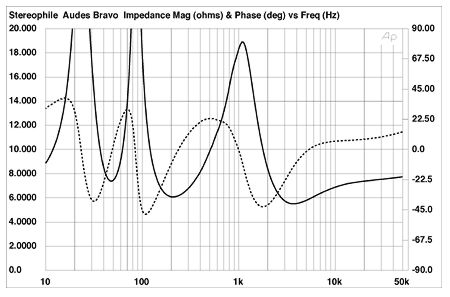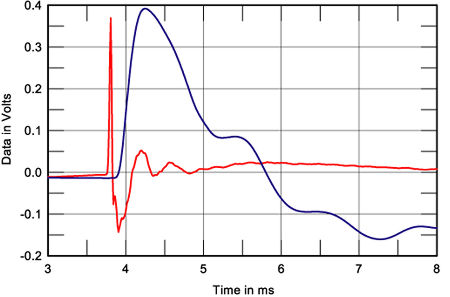| Columns Retired Columns & Blogs |
Audes Bravo loudspeaker Measurements
Sidebar 3: Measurements
As is to be expected for a speaker this small, the Audes Bravo's sensitivity was on the low side, at an estimated 83dB(B)/2.83V/m. It will therefore need a lot of amplifier watts to play loud, except that it will then start to run up against its small woofer's dynamic-range limitations. However, its impedance plot (fig.1) revealed it to be a fairly easy load for an amplifier to drive, with an impedance magnitude that remains above 6 ohms for almost all the audioband. Although the electrical phase angle does reach 45 degrees on a couple of occasions, this is always when the magnitude is high enough to mitigate the potential drive difficulty. The saddle at 48Hz in the impedance-magnitude curve indicates the tuning of the rear-facing port and suggests modest bass extension—again, as is to be expected from a small speaker.

Fig.1 Audes Bravo, electrical impedance (solid) and phase (dashed) (2 ohms/vertical div.).
However, that the Bravo has a small cabinet is an advantage when it comes to vibrational resonances in the cabinet walls, in that these walls will be inherently more stiff than in a larger speaker. In conjunction with the small dimensions, this pushes up the frequency of such a resonance to a region where it will have less subjective effect. The fig.1 traces were relatively free from the small wrinkles that would indicate the presence of such resonances, and fig.2—a cumulative spectral-decay plot calculated from the output of an accelerometer fastened to the back panel between the port and the terminal panel—shows that the only significant mode lies at a high 766Hz.

Fig.2 Audes Bravo, cumulative spectral-decay plot calculated from the output of an accelerometer fastened to the cabinet's rear panel between the port and terminal panel (MLS driving voltage to speaker, 7.55V; measurement bandwidth, 2kHz).
Fig.3 shows, from left to right, the individual responses of the port, woofer, and tweeter. (The middle trace is a composite of two measurements, one taken in the farfield above 350Hz, the other taken in the nearfield below 350Hz; the tweeter response is farfield alone, the port response is nearfield alone.) The notch at 50Hz in the woofer's output confirms the tuning of the port, which peaks broadly at the same frequency. Any higher-frequency misbehavior in the port's output is well suppressed. The woofer crosses over to the tweeter at around 2kHz, with quite steep out-of-band rollouts, but note the severe peak-notch combination in the woofer's response around 1kHz. There's something amiss here.

Fig.3 Audes Bravo, acoustic crossover on tweeter axis at 50", corrected for microphone response, with the nearfield woofer and port responses plotted below 350Hz and 1kHz, respectively.
This aberration can also be seen in fig.4, the Bravo's overall farfield response averaged across a 30 degrees horizontal window on the tweeter axis and spliced at 300Hz to the complex sum of the individual nearfield responses. I would have expected this misbehavior to give rise to a distinctly nasal coloration. Bob Reina didn't comment on such a coloration in his auditioning notes, but he was bothered by "a very narrow range of frequencies in the upper midrange and lower highs in which a solo instrument in a highly modulated passage would tend to be pushed forward in the mix, with a slightly 'hooty' quality." It's pretty much certain that his finding stems from this measured behavior.

Fig.4 Audes Bravo, anechoic response on tweeter axis at 50", averaged across 30 degrees horizontal window and corrected for microphone response, with the complex sum of the nearfield woofer and port responses, taking into account acoustic phase and distance from the nominal farfield point, plotted below 300Hz.
With its offset drive-units, the Bravo's lateral dispersion (fig.5) varies according to whether the measurement was off-axis on the tweeter side of the front baffle (foreground of the graph) or the woofer side (background). The contour lines in this graph are generally even, which ties in with the good stereo imaging BJR noted. But note the more pronounced presence-region flare off-axis on the woofer side; if Bravos sound too bright in your room, it would be well worthwhile to place them so that their tweeters are on the outside edges. The 1" tweeter becomes directional above 10kHz, which no doubt contributed to BJR's feeling that the Bravo lacked "top-end sparkle." The speaker's dispersion in the vertical plane (fig.6) suggests that high stands will work better than low ones.

Fig.5 Audes Bravo, lateral response family at 50", normalized to response on tweeter axis, from back to front: differences in response 90 degrees-5 degrees off-axis on woofer side of baffle, reference response, differences in response 5 degrees-90 degrees off-axis on tweeter side of baffle.

Fig.6 Audes Bravo, vertical response family at 50", normalized to response on tweeter axis, from back to front: differences in response 45 degrees-5 degrees above axis, reference response, differences in response 5 degrees-45 degrees below axis.
The Bravo's step response (fig.7) suggests that both drive-units are connected with the same, positive acoustic polarity, with the tweeter's output leading that of the woofer by a couple of hundred microseconds. The smooth transition of the tweeter's step to that of the woofer confirms the crossover's good frequency-domain integration. However, looking at the drivers' individual step responses (fig.8) reveals the presence of post-excitation ringing in both. Though basically clean, the farfield cumulative spectral-decay plot (fig.9) is therefore marred by two ridges of resonant energy: one in the 1kHz region, associated with the woofer's frequency-response problem noted earlier, and the other at 4.4kHz. The latter will probably be subjectively benign.

Fig.7 Audes Bravo, step response on tweeter axis at 50" (5ms time window, 30kHz bandwidth).

Fig.8 Audes Bravo, individual step responses on tweeter axis at 50" of woofer (blue) and tweeter (red). (5ms time window, 30kHz bandwidth.)

Fig.9 Audes Bravo, cumulative spectral-decay plot at 50" (0.15ms risetime).
The Audes Bravo is a well-finished, generally well-engineered little speaker. However, I was concerned by the measured problem in the upper midrange, and am somewhat surprised that BJR was not more bothered by it.—John Atkinson
- Log in or register to post comments




































